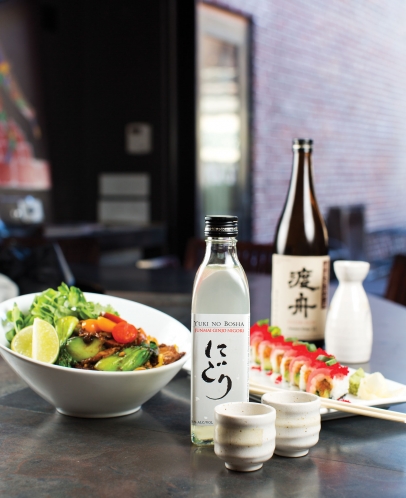Head to Sake School
There are plenty of misconceptions floating around about sake, Japan’s indigenous and traditional alcoholic beverage, dating back more than 2,000 years. We’ll often hear “you should never drink sake warm,” “it causes terrible hangovers,” or “it’s essentially a rice wine.” As we’ve come to learn through our “research,” statements like these are all baseless.
In actuality, sake is more similar to beer than wine because it’s brewed. The traditional process begins with polishing the outer portion of the rice grain, mostly comprised of protein and fat. Inside the rice kernel lies an even smaller, starchy kernel. The more that’s polished away, the better the quality of the sake. Then, the brewers introduce koji, a culture that catalyzes the fermentation process and breaks down the starch into sugar within the rice and water mixture. More water is added at the end, to bring the alcohol content down to sake’s normal range, 15 to 20 percent. And sometimes, producers add more alcohol, not to increase its booziness, but to smooth out the flavor.
“Another difference is that most sake doesn’t contain sulfates like wine does, which causes allergy problems for a lot of people and hangovers,” notes Aimee Marshall, bar manager at PAN Asian Restaurant.


The concept of regionality in sake also differs greatly from that of wine. “In Japan, ‘prefectures’ are the equivalent to wine regions or appellations. Not all rice is the same and they wouldn’t use table rice to make sake, so depending on the temperature and season, you’ll get a different product. Most people who study Japanese geography would be able to judge a sake from that,” explains Danny Nguyen, restaurant manager at PLUM Pan Asian Kitchen. The origin of the water utilized in the brewing process also matters, adds Collin McNamee, beverage director at Soba and Umi.
Yet, many sake breweries don’t necessarily follow with the brewing style associated with their region. For the majority of us, McNamee says, “Information on a menu will tell you the grade of sake, but it’s not necessarily going to tell you what it tastes like. That’s where you should rely on your server to guide you.” While many are probably familiar with sake bombs, or hot sake and a beer, he recommends two routes for beginners: starting at the top with a daiginjo [he promises it won’t be much more expensive than a lower-grade sake] or a sweet nigori, since sake will likely taste very dry at first.
Over in bustling East Liberty, PLUM offers guests the opportunity to try a variety of sakes with flights of either three or five 2-oz. tastes.“I chose to do the flights because sake is all very different and subjective,” says Kory Husson, beverage manager at PLUM. “For a beginner, it allows you to taste a really big range and learn what you like.”
When it comes to sake and food pairings, the general consensus among experts is that opposites attract. Says McNamee, “Unlike wine where you would pick flavors that match, with sake I would actually pick flavors that contrast.” Meaning that the full-bodied, sweeter, creamier taste of a nigori can stand up to heavier, meatier, and spicier dishes, while a delicate, dry-tasting daiginjo pairs best with a sushi or lighter fish because they won’t interfere with each other’s flavors. “Also unlike wine, it can go with things like vinegar. So much sake lends itself to food because it was created as an afterthought. It was always meant to complement food.”


Current sake trends on both a local and national level show a shift toward the production of more premium sakes, more small producers, and more experimentation, a parallel which also reflects the craft beer industry. Notable examples include Gekkeikan Zipang sparkling sake and flavored sakes that infuse seasonal florals like cherry blossoms in the fermentation process (which are later filtered out), both at PLUM; and Kibo, a canned junmai sake from the Suisen Shuzo brewery in Japan that rose from the rubble of the devastating 2011 tsunami, available at PAN. Americans are even getting in on the action with sake breweries popping up out west in Washington and Oregon. And, local bartenders like Husson, who takes pride in his classic craft cocktails with an Asian twist, are experimenting with sake to introduce new flavors to diners. PLUM’s menu features his refreshingly delicious thai basil mojito with nigori sake and “sake tea,” where he steeps a choice of Tea Forté in hot sake, removing the bite completely. “It’s fun to try,” says McNamee. “If you’re enjoying an exotic cuisine, you should be open to trying the drinks, too. It really can transform you and take you away.”
Speak Sake
When reading a sake menu, you’ll want to know these terms:
Nigori - Sake that’s coarsely filtered, giving it a cloudy, white appearance.
Junmai - Pure sake that’s only made using rice, water, and koji.
Honjozo - Sake brewed with rice, water, koji, and added yeast and alcohol that’s typically served warm.
Ginjo - A step up from honjozo with at least 40 percent of the rice grain milled down. Alcohol is added.
Daiginjo - The highest grade of sake with at least 50 percent of the rice grain milled down. Alcohol is added.
Junmai Ginjo & Daiginjo - Ginjo and Daiginjo sake without additional alcohol or added yeast.
Hot or Cold?
“Traditionally, people in Japan thousands of years ago would heat sake to get rid of the impurities,” says Nguyen. Though impurities aren’t a concern today, the tradition and style stuck. It’s best to reserve lower-grade sake like junmai and honjozo to drink warm, as heat can smooth out the taste and draw out more complex flavors. Ginjo and daiginjo sakes are usually best chilled, as the cold enhances their flavors and aromas, says Nguyen. However, personal preference always takes precedence.
Photos left to right: PLUM Pan Asian Kitchen’s sushi manager, Kelsang Gyalsen, prepares a traditional plate of sushi and nigiri to pair with this delicate junmai sake, Soba’s dolsot bi bim bap — comprised of beef tenderloin, poached egg, pickled shiitake, kimchi, mung bean sprouts, nori, and gochujang — is a Korean dish that pairs well with sake, Collin McNamee, beverage director at Soba and Umi, demonstrates pouring this nigori sake in the traditional, two-handed method.
PAN Asian Restaurant, 3519 Butler St., Lawrenceville. 412.325.3435. panasianpgh.com. PLUM Pan Asian Kitchen, 5996 Centre Ave., East End. 412.363.7586. plumpanasiankitchen.com. Soba, 5847 Ellsworth Ave., Shadyside. 412.362.5656. sobapa.com. Umi, 5849 Ellsworth Ave., Shadyside. 412.362.6198. bigburrito.com/umi.





